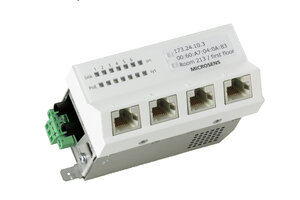Viewpoints with respect to in-house networking have also changed. Previously considered more as a means to an end, a perspective is increasingly prevailing which regards the IT infrastructure as a part of the whole. This particularly applies to IT energy and life cycle costs, which are also being assigned increasing significance in the most recent revision of the Regulation on the Award of Public Contracts.
Fiber To The Office - Economical in-house networking with hybrid technology for government agencies and public administration
Energy efficiency in the focus of public regulations
Long service life and energy efficiency are especially important for IT networking in the public sector. This is also often confirmed by amendments to the Regulation on the Award of Public Contracts that puts a new economic focus on energy efficiency and life cycle costs.
Energy aspects of the IT building infrastructure in the overall view
Energy aspects already play an important role in the conception of public buildings. Here the alignment of the building, the distribution of heating and cooling, the insulation materials and many other aspects are considered in order to save energy. The energy efficiency of the IT building infrastructure used plays a decisive role here. This is why MICROSENS already takes the increasing requirements of energy efficiency into account when developing new components and uses only energy-saving chipsets and mains adaptors with a high level of efficiency.
Thus MICROSENS Fiber To The Office serves as an important building block of the IT infrastructure to provide a high-performance network and to reduce energy and operating costs.
Investment protection and reduced life cycle costs
Fiber To The Office combines the best of two worlds. For one thing, it offers the technical advantages of fiber optic cabling: long range, interference immunity, security against interception. Fiber To The Office also brings the flexibility of twisted pair at the end device back into play. In this way important technologies like Power-over-Ethernet and VoIP can be effectively and universally used. Avoiding floor distribution enables considerable savings potential in comparison to structured cabling solutions: less active network components and lower costs for climate control and UPS systems. In addition to this, the horizontal cabling is maintained in its entirety in the event of a future technology change. In this way, the FTTO concept of MICROSENS unites the investment protection of fiber optic cabling with the flexibility of twisted pair close to the user.

State-of-the-art security standards, easy administra-tion, quick installation
The Micro Switches are suita-ble for a wide variety of instal-lation scenarios. MICROSENS also provides special series with special surfaces in accordance with customer wishes. Firmware and security functions are constantly kept up-to-date by our German development team.
- Gigabit Ethernet technology with fiber optic uplinks in ST, SC or SFP connection technology
- Including all important security protocols (authentication in accordance with IEEE 802.1X, RADIUS)
- Power-over-Ethernet with external mains adaptor and galvanic separation
- Management software (NMP) with SNMPv3 and SSH
- LLDP auto-discovery
- Tool-free installation, vertical and horizontal
New flexibility through migration of Fiber To The Desk to FTTO

Fiber optics is the medium of the future. This is why many bodies of public admini-stration, government agencies and ministries have decided in favour of purely fiber optic-based in-house cabling according to the Fiber To The Desk (FTTD) model. These installations in some case originate from the time long before the wide distribution of Voice-over-IP and Power-over-Ethernet. However, the decision for building networking with fiber optics does not have to be a dead end. A migration from FTTD to FTTO enables the use of Power-over-Ethernet, creates new flexibility and exploits the advantages of the already existing fiber optic cabling.
Great flexibility of Fiber To The Office reduces IT operating costs
Fiber optic cabling provides a long service life, great reliability and excellent interference immunity; however, close to the user it does not offer the flexibility of copper cabling. The possibilities for universal usage of VoIP and Power-over-Ethernet are thus greatly limited with pure fiber optic cabling. This is a factor that can be problematic for government agencies, because it makes the introduction of VoIP telephony more difficult. With a conversion to Fiber To The Office, government agencies and ministries can increase the flexibility of their building infrastructure in a targeted fashion and restore the perfect balance between security for the future and cost efficiency.
Seamless integration into the existing building structure
MICROSENS Micro Switches are the ideal solution for enabling universal usage of PoE within FTTD installations. The unique design of the MICROSENS Micro Switches enables tool-free installation within dado trunking or underfloor tanks and thus seamless integration into the respective conditions of the building. The switches replace the passive fiber optic outlet boxes and provide an efficient PoE power supply directly in the cable trunk. Through combination with the central PoE power supply concept of MICROSENS, it is also possible to further increase the reliability and energy efficiency of the FTTO installation.
New capacities for the connection of computer workspaces
Another benefit of the conversion to FTTO is the multiplication of ports. Up to four copper ports are created from one fiber optic connection as a result of the migration to FTTO. These can be used as desired for the connection of work space computers, printers and VoIP telephones. In this way, considerably more network connections are made available with minimal investment. Government agencies thus acquire more flexibility for potential expansions and make optimal use of the already existing infrastructure in the process.
Government agencies and public administration thus profit from FTTO in the following ways:
- Universal usage of Power-over-Ethernet enables VoIP telephony
- Minor installation work and optimal usage of the already existing fiber optics infrastructure
- Seamless integration into the existing building structure with cable trunk installation
- Provision of additional network connections for the connection of work space computers
- Cost reductions due to energy-efficient power supply of PoE devices and the observance of the highest security standards and central management
Optical Transport Platform, ready for the future – Use fiber optics capacity more efficiently with xWDM

With around 400 locations, the German administrative system is one of the largest operators of computer centers in Germany. The focus is on process optimisation and consolidation in the context of cost reduction measures. Whether Shared Service Center or the coupling of computer centers, the key to increased cost efficiency lies in high performance networking that can promptly react to rapidly growing broadband requirements.
Cost-efficient usage of fiber optic capacities
The optical multiplex technology makes it possible to economically multiply the capacity of existing fiber optic lines. Parallel transmission of multiple wavelengths over one fiber optic connection enables transmission rates of up to several hundred Gigabits per second with no need to lay any additional fiber optic cables. MICROSENS accompanies major public sector projects in close cooperation with expert planners and integrators. Decades of experience and the most modern measurement methods thus ensure the optimal integration of the MICROSENS Optical Transport Platform into the customer infrastructure.
Minor initial investment, low operating costs, always scalable
The “pay-as-you-grow” idea has long been a prevalent investment planning principle among telecommunications providers, and today it is equally applicable to the networking of computer centers in the public sector. This is because the economy and the public sector are both increasingly subject to the same business management principles. The modular design of the MICROSENS Optical Transport Platform enables the optimal reconciliation of investment costs and needs. Should transmission performance requirements increase or additional services be required, additional modules can be retrofitted without a loss of investments.
High performance location networking and computer center coupling
Short latency periods combined with full protocol transparency form the perfect basis for the transmission of sophisticated SAN services or the networking of locations. Furthermore the TDM-over WDM technology allows massive cost reduction for the IT infrastructure by transmitting several protocols over one wavelength.
Innovativ advantanges of the Optical Transport Platform
- High reliability, redundant construction, scalability, protocol transparency
- Efficient green IT technology: Single-chip technology helps reduce operating costs by up to 25 per cent compared to conventional multi-chip solutions.
- Storage support: 1G/ 2G/ 4G/ 8G/ 10G Fibre Channel, InfiniBand, ECON/FICON and all other relevant protocols
- Perfect integration into the customer infrastructure through Brocade certification
- Multi-rate technology enables the parallel transmission of various protocols (Ethernet, SDH, Fibre Channel) and data rates (100 Mbps – 40 Gbps) on one wavelength. Depending upon the network structure, reduces the infrastructure costs for aggregation and operation by up to 60 per cent.
- Legacy interoperability enables transmission on SONET/SDH wavelengths.
- CWDM / DWDM modules for bandwidths from 100 Mbps to 40 Gbps
- FIPS compatible Fibre Channel encoding
- Hut-skipping transmission; range of up to 300 km without an additional optical amplifier










